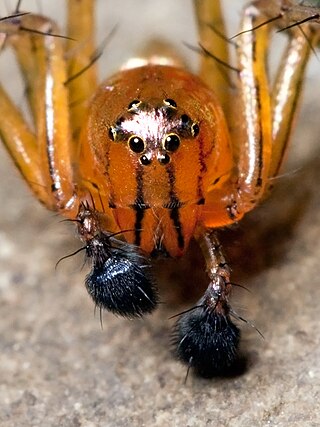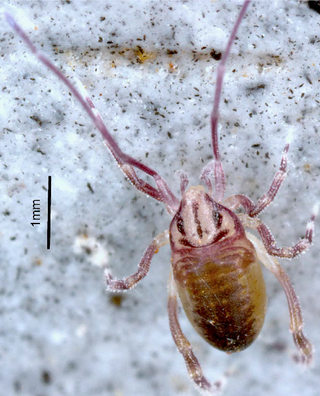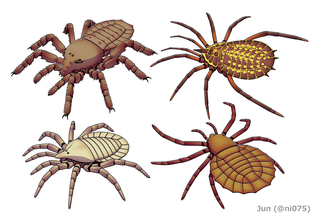
Arachnida is a class of joint-legged invertebrate animals (arthropods), in the subphylum Chelicerata. Arachnida includes, among others, spiders, scorpions, ticks, mites, pseudoscorpions, harvestmen, camel spiders, whip spiders and vinegaroons.

Amblypygi is an order of arachnid chelicerate arthropods also known as whip spiders or tailless whip scorpions. The name "amblypygid" means "blunt tail", a reference to a lack of the flagellum that is otherwise seen in whip scorpions. Amblypygids possess no silk glands or venomous fangs. They rarely bite if threatened, but can grab fingers with their pedipalps, resulting in thorn-like puncture injuries.

Thelyphonida is an arachnid order comprising invertebrates commonly known as whip scorpions or vinegaroons. They are often called uropygids in the scientific community based on an alternative name for the order, Uropygi. The name "whip scorpion" refers to their resemblance to true scorpions and possession of a whiplike tail, and "vinegaroon" refers to their ability when attacked to discharge an offensive, vinegar-smelling liquid, which contains acetic acid.

Ricinulei is a small order of arachnids. Like most arachnids, they are predatory, eating small arthropods. They occur today in west-central Africa (Ricinoides) and the Neotropics as far north as Texas. As of 2021, 91 extant species of ricinuleids have been described worldwide, all in the single family Ricinoididae. In older works they are sometimes referred to as Podogona. Due to their obscurity they do not have a proper common name, though in academic literature they are occasionally referred to as hooded tickspiders.

Pedipalps are the second pair of appendages of chelicerates – a group of arthropods including spiders, scorpions, horseshoe crabs, and sea spiders. The pedipalps are lateral to the chelicerae ("jaws") and anterior to the first pair of walking legs.

Opilioacaridae is the sole family of mites in the order Opilioacarida, made up of about 13 genera. The mites of this family are rare, large mites, and are widely considered primitive, as they retain six pairs of eyes, and abdominal segmentation. They have historically been considered separate from other mites belonging to Acariformes and Parasitiformes, but are now generally considered a subgroup of Parasitiformes based on molecular phylogenetics.

The order Trigonotarbida is a group of extinct arachnids whose fossil record extends from the late Silurian to the early Permian. These animals are known from several localities in Europe and North America, as well as a single record from Argentina. Trigonotarbids can be envisaged as spider-like arachnids, but without silk-producing spinnerets. They ranged in size from a few millimetres to a few centimetres in body length and had segmented abdomens (opisthosoma), with the dorsal exoskeleton (tergites) across the backs of the animals' abdomens, which were characteristically divided into three or five separate plates. Probably living as predators on other arthropods, some later trigonotarbid species were quite heavily armoured and protected themselves with spines and tubercles. About seventy species are currently known, with most fossils originating from the Carboniferous coal measures.

The evolution of spiders has been ongoing for at least 380 million years. The group's origins lie within an arachnid sub-group defined by the presence of book lungs ; the arachnids as a whole evolved from aquatic chelicerate ancestors. More than 45,000 extant species have been described, organised taxonomically in 3,958 genera and 114 families. There may be more than 120,000 species. Fossil diversity rates make up a larger proportion than extant diversity would suggest with 1,593 arachnid species described out of 1,952 recognized chelicerates. Both extant and fossil species are described annually by researchers in the field. Major developments in spider evolution include the development of spinnerets and silk secretion.
Phrynus marginemaculatus is a species of amblypygid found in southern Florida, the Bahamas, Cuba, and Hispaniola. They are nocturnal predators that hide during the day in small retreats.
Herbert Walter Levi was professor emeritus of zoology and curator of arachnology at the Museum of Comparative Zoology, Harvard University. He was born in Germany, educated there and at Leighton Park School, Reading in England. He then received his higher education at the University of Connecticut and the University of Wisconsin. Levi authored about 150 scientific papers on spiders and on biological conservation. He is the author of the popular Golden Guide Spiders and their Kin, with Lorna Rose Levi and Herbert Spencer Zim.

Phrynus is a genus of whip spiders found in tropical and subtropical regions, mostly in the new world.

Phrynus longipes is a species of amblypygid often found in the Caribbean. They are also found in other warm climate areas such as the forests of Central America. Within this region, however, Phrynus longipes lives in an array of habitats from caves to coastlines. They are protective of their territory, using their pedipalps to deter predators or unwanted visitors. Being nocturnal predators, they take shelter during the day and hunt primarily at night. Phrynus longipes feed on both vertebrates and invertebrates. They are the first amblypygid to be recorded feeding on an avian species.
Sarax is a genus of amblypygids of the family Charinidae.
Phrynus garridoi is a species of Amblypygi in the family of Phrynidae.

Paracharon is a genus of tailless whip scorpion, native to West Africa and northern South America. A single species, Paracharon caecus has been described. It is endemic to Guinea-Bissau. An undescribed species is known from Colombia. It is the most basal known living member of Amblypygi, and the only living member of the Palaeoamblypygi, which also includes the genus Weygoldtina from the Carboniferous of Euramerica and Paracharonopsis from Eocene aged Indian Cambay amber. Both living species are troglobites, having no eyes, with P. caecus living in termite nests, while the undescribed Colombian species was found living in a cave.

Weygoldtina is an extinct genus of tailless whip scorpion known from Carboniferous period, and the only known member of the family Weygoldtinidae. It is known from two species described from North America and England and originally described in the genus Graeophonus, which is now considered a nomen dubium.
Weygoldtia is a genus of amblypygids of the family Charinidae, described in 2018 by Gustavo Silva de Miranda, Alessandro P.L. Giupponi, Lorenzo Prendini and Nikolaj Scharff. The genus is named after the German arachnologist Peter Weygoldt, in recognition of his contributions to the study of Amblypygi.

Paracharontidae is an arachnid family within the order Amblypygi. Paracharontidae and the extinct Weygoldtinidae from the Carboniferous form the suborder Paleoamblypygi, the sister group to the remaining Amblypygi. The family contains two genera: The extinct Paracharonopsis Engel and Grimaldi, 2014 from the Eocene (Ypresian) aged Cambay amber of India, and Paracharon, with two extant species: Paracharon caecus Hansen, 1921 from Guinea-Bissau in West Africa, and an undescribed species from Colombia in northern South America.
Catageus is a genus of amblypygids of the family Charontidae.












